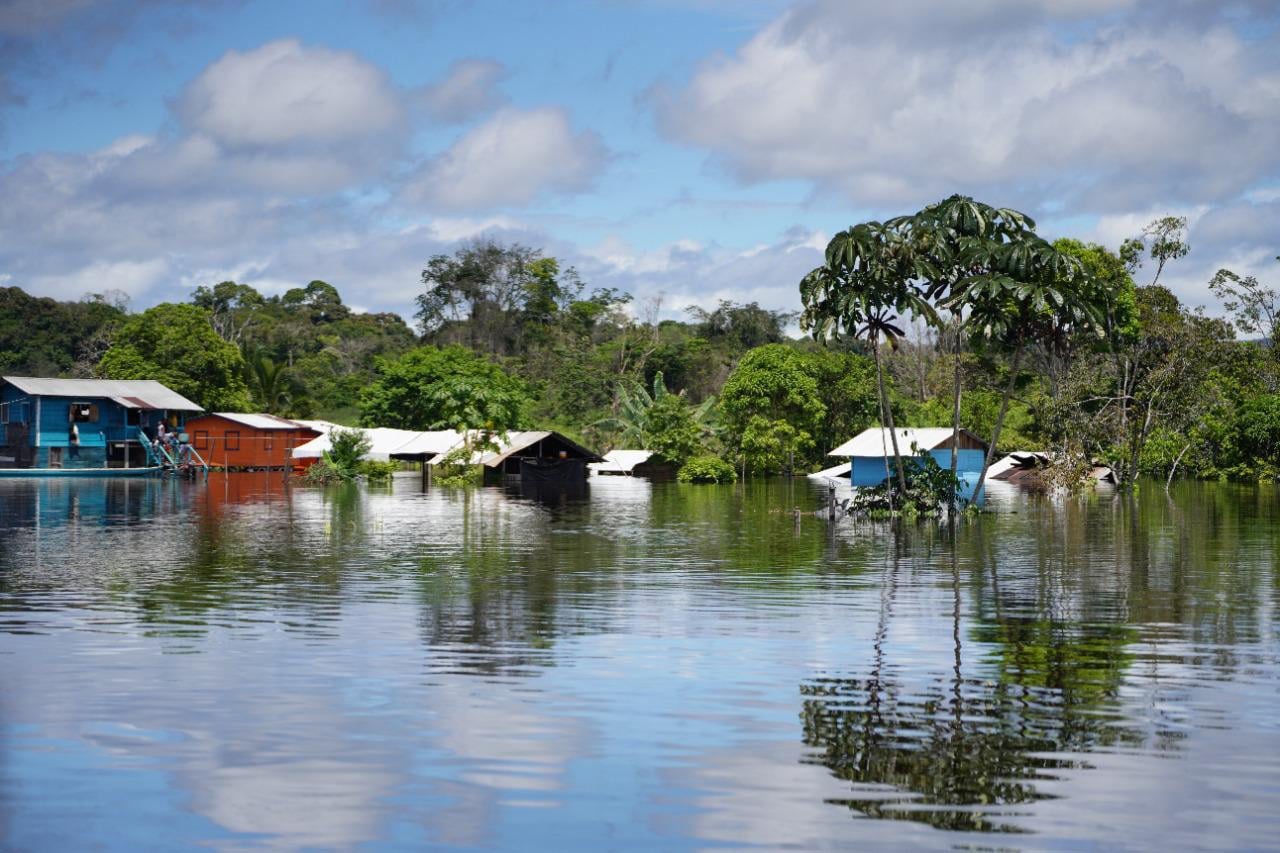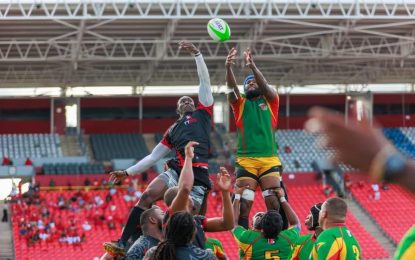Latest update November 22nd, 2024 1:00 AM
Latest News
- Exxon wants new oil block on own terms
- Indian companies eye Guyana’s oil
- ICC issues arrest warrant for Israeli PM Netanyahu for ‘war crimes’ in Gaza
- Developing countries should not be curtailed in exploiting natural resources- PM Modi tells Parliament
- Jagdeo was sold expired soft drink at Marriott Hotel
Climate Change impacts could cost oil rich Guyana US$800M
Nov 25, 2021 News
—Govt. Report says over 300,000 citizens could be harmed
By Kiana Wilburg
Kaieteur News – Since the 1960s, increases in temperature, sea level and extreme rainfall have exposed just how vulnerable Guyana is to climate change. This frightening global phenomenon has resulted in more than US$600M in losses. That figure could however see an alarming spike as two government reports predict that more climate woes of potentially catastrophic proportions lie ahead for the world’s latest oil exploration hotspot.
According to the 2015 Climate Resilience Strategy and Action Plan for Guyana, climate change will no doubt alter the characteristics of hazards Guyana is exposed to (e.g. average annual rainfall) and the nature of variability (e.g. more intense storms, irregular seasonal rainfall), which will hamper the nation’s socio-economic development objectives. The report further notes, “It is estimated that by 2030 Guyana could be exposed to cumulative annual flood-related losses totalling US$150 million and that an extreme event similar to the serious flooding in 2005, which resulted in losses equivalent to 60% of GDP, could result in some US$0.8 billion in losses and harm more than 320,000 people.”
The report also states that Guyana’s vulnerability to weather and climate-related impacts is partly as a result of inherent characteristics of the country’s geography and socio-economic development profile. It says these factors interact with the climate hazards to which Guyana is exposed and result in a range of climate impacts. The document says they include ageing and inadequately maintained critical infrastructure, limited access to the latest knowledge and technology, and wider poverty and development challenges. Unless addressed, the 2015 government report warned that these factors will increase Guyana’s sensitivity, and in turn vulnerability, to future climate impacts.
The recently launched draft of the PPP/C Government’s Low Carbon Development Strategy (LCDS) 2030 also acknowledges the foregoing findings while expounding on the extent of climate change impacts on the nation.
The draft LCDS states that the effects on Guyanese people, society, economy and the environment during flooding events in 2005, 2006, 2008, 2010, 2011, 2013, 2014 and 2015 and the droughts of 1997-1998, 2009-2010 and 2015-2016 are poignant examples of the devastation climate change may cause.
It pointed out that flooding in 2005, for example, caused damage estimated at US$465 million (60% of GDP at that point). This event is reported to have affected close to 275,000 people (37% of the population). It was caused by a combination of a wetter than average December (2004), which left the ground saturated, followed in January 2005 by some of the heaviest rainfall the country has experienced since records began in 1888. Kaieteur News understands that some areas reported as much as 120-150cm of standing water, which remained for several days. The heavy rainfall also caused an increase in the water levels of the East Demerara Water Conservancy Dam (EDWC), which came close to a critical breaching level (59ft) and could have resulted in the failure of the dam wall. A socio-economic assessment of the damage and loss caused by the 2005 flood revealed major impacts to the agriculture sector, particularly in the regions of West Demerara/Essequibo Islands, Demerara/Mahaica and Mahaica/West Berbice. Region Four was most severely affected, experiencing close to 55% of the total damage, followed by Regions Two (23%) and Five (19%). Considerable losses were recorded in the sugar, rice, livestock and other crop (fruits, vegetables, roots and tubers, and herbs and spices) subsectors.
For the floods experienced earlier this year, President Irfaan Ali described it as unprecedented and one of the worst disasters in the country’s history. The draft LCDS states that the social and economic damage is likely comparable to the 2005 flood which affected close to 37% of the population and caused economic damage equivalent to 60% of GDP.
In his address to the nation, the President said that in May alone, Guyana had experienced its second highest rainfall in 40 years. He said the resulting impact saw massive flooding across all 10 Administrative Regions with over 300 communities directly affected for a protracted period of time. Furthermore, the President said that the Agriculture Sector suffered the greatest loss with 92,000 acres of farm and farmlands completely affected. He disclosed that the sugar industry was also significantly affected with estimated losses in the fields of over $1.5B. Kaieteur News had reported that over 50 percent of mining operations were affected, as mining communities were cut-off as a result of infrastructural damage. Government’s initial assessment estimates rehabilitation work in excess of $1B for the mining community. Damage to the Forestry Sector; loss of production and damage to equipment is estimated in excess of $8B.
In response to the massive disruption in the economy, the Government had committed to direct transfers to households and farmers to allow them in the first instance, to return to some level of normalcy in their homes whilst supporting the agriculture sector. Approximately $10B was subsequently approved by the National Assembly in supplementary provisions to address these needs.
DROUGHT
While heavy rainfalls which lead to floods have affected the nation over the years, it is not the only climate emergency Guyana faces. Drought is also a concern for the oil producing state, particularly in the Hinterland Region.
Following an extended period of dry weather in late 2014 and early 2015, the draft LCDS report notes that the Hinterland was facing drought conditions by April 2015. Region Nine (Upper Takutu-Upper Essequibo) and parts of Region One (Barima-Waini) were particularly affected, resulting in the reduction of agricultural output in the Regions, reduction in available water supply and increased dust pollution among other issues. The lack of rainfall also caused decreased water levels in the wells, lakes, ponds, rivers, creeks and other water sources. Frequent bush fires, destroyed several farms at Aranaputa and local communities experienced limited access to potable water for domestic and agriculture use. Residents were also forced to go to local rivers, including the Rupununi River, for untreated water for domestic use.
With increases in the number of dry spells, drought conditions and changing rainfall patterns, the report states that stress on Guyana’s internal water resources, aquifers and rivers is increasing.
With resources from the Guyana-Norway Partnership, the PPP/C administration reminded that policy leaders under the guidance of industry experts developed the Climate Resilience and Adaptation Strategy which sets out a comprehensive and overarching framework for adapting and building resilience to climate change impacts.
In 2021, the government said work will re-start to implement the strategy. Specifically, it said the most important elements of the CRSAP will be brought up to date. Funding will be allocated to four priority climate resilience programmes, and a strategy to finance the remainder of the CRSAP from ecosystem services payments and other sources will be put in place.
Share this:
- Click to print (Opens in new window)
- Click to email a link to a friend (Opens in new window)
- Click to share on Facebook (Opens in new window)
- Click to share on WhatsApp (Opens in new window)
- Click to share on Twitter (Opens in new window)
- Click to share on Pinterest (Opens in new window)
- Click to share on Pocket (Opens in new window)
- Click to share on Tumblr (Opens in new window)
- Click to share on Reddit (Opens in new window)
- Click to share on LinkedIn (Opens in new window)
Related
Similar Articles

The Glenn Lall Show | November, 20th, 2024
Follow on Tik Tok @Glennlall
THE BLUNT OF THE DAY

Sports
Nov 22, 2024
-Guyana to face Canada today By Rawle Toney The Green Machine, Guyana’s national rugby team, is set to make its mark at this year’s Rugby Americas North (RAN) Sevens Championship, hosted at...Features/Columnists
A false panacea for electoral integrity
…Peeping Tom kaieteur News – Advocates for fingerprint verification in Guyana’s elections herald it as... more
Rising Gun Crimes in the Caribbean: Urgent Action required by all
By Sir Ronald Sanders Kaieteur News – There is an alarming surge in gun-related violence, particularly among younger... more
Publisher’s Note
Freedom of speech is our core value at Kaieteur News. If the letter/e-mail you sent was not published, and you believe that its contents were not libellous, let us know, please contact us by phone or email.
Feel free to send us your comments and/or criticisms.
Contact: 624-6456; 225-8452; 225-8458; 225-8463; 225-8465; 225-8473 or 225-8491.
Or by Email: [email protected] / [email protected]
Weekend Cartoon















